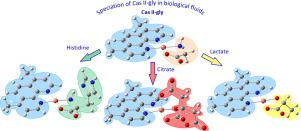Journal of Inorganic Biochemistry ( IF 3.9 ) Pub Date : 2021-08-11 , DOI: 10.1016/j.jinorgbio.2021.111566 Valeria Ugone 1 , Federico Pisanu 2 , Daniele Sanna 1 , Eugenio Garribba 2

|
Casiopeinas® are among the few CuII compounds patented for their antitumor activity, but their mode of action has not been fully elucidated yet. One of them, Cas II-gly, is formed by 4,7-dimethyl-1,10-phenanthroline (Me2phen) and glycinato (Gly). In blood and cells, Cas II-gly can keep its identity or form mixed species with serum or cytosol bioligands (bL or cL) with composition CuII–Me2phen–bL/cL, CuII–Gly–bL/cL, or CuII–bL/cL. In this study, the binding of Cas II-gly with low molecular mass bioligands of blood serum (citric, L-lactic acid, and L-histidine) and cytosol (reduced glutathione (GSH), reduced nicotinamide adenine dinucleotide (NADH), adenosine triphosphate (ATP), and l-ascorbic acid) was examined through the application of instrumental (ElectroSpray Ionization-Mass Spectrometry and Electron Paramagnetic Resonance) and computational (Density Functional Theory) methods. The results indicated that mixed species CuII–Me2phen–bL/cL are formed, with the bioligands replacing glycinato. The formation of these adducts may participate in the copper transport toward the target organs and facilitate the cellular uptake or, in constrast, preclude it. In the systems with GSH, NADH and L-ascorbate, a redox reaction occurs with the partial oxidation of cL to the corresponding oxidized form (GSSG, NAD+ and dehydroascorbate) which interact with CuII. Formed CuI ion does not give complexation reactions with reduced or oxidized form of bioligands for its ‘soft’ character and low affinity for oxygen and nitrogen donors compared to CuII. However, CuI could promote Fenton-like reactions with production of reactive oxygen species (ROS) related to the antitumor activity of Casiopeinas®.
中文翻译:

强效抗肿瘤化合物 Casiopeinas® 与血清和细胞生物配体的相互作用
Casiopeinas® 是少数因其抗肿瘤活性而获得专利的 Cu II化合物之一,但其作用方式尚未完全阐明。其中之一,Cas II -gly ,由 4,7-二甲基-1,10-菲咯啉 (Me 2 phen ) 和甘氨酸 (Gly) 形成。在血液和细胞中,Cas II -gly 可以保持其身份或与血清或胞质溶胶生物配体(bL或cL)形成混合物种,组成为 Cu II –Me 2 phen– bL / cL , Cu II –Gly– bL / cL ,或 Cu II – bL / cL. 在这项研究中,Cas II - gly与血清(柠檬酸、L-乳酸和 L-组氨酸)和细胞质(还原型谷胱甘肽 (GSH)、还原型烟酰胺腺嘌呤二核苷酸 (NADH)、通过应用仪器(电喷雾电离质谱和电子顺磁共振)和计算(密度泛函理论)方法检查三磷酸腺苷 (ATP) 和l-抗坏血酸。结果表明,混合物种 Cu II –Me 2 phen– bL / cL形成,生物配体取代甘氨酸。这些加合物的形成可能参与铜向靶器官的转运并促进细胞摄取,或者相反,排除它。在具有 GSH、NADH 和 L-抗坏血酸盐的系统中,发生氧化还原反应,将cL部分氧化为与 Cu II相互作用的相应氧化形式(GSSG、NAD +和脱氢抗坏血酸盐) 。与 Cu II相比,形成的 Cu I离子不会与还原或氧化形式的生物配体发生络合反应,因为其“软”特性和对氧和氮供体的低亲和力。然而,Cu I可以促进类芬顿反应,产生与 Casiopeinas® 的抗肿瘤活性相关的活性氧 (ROS)。

























 京公网安备 11010802027423号
京公网安备 11010802027423号